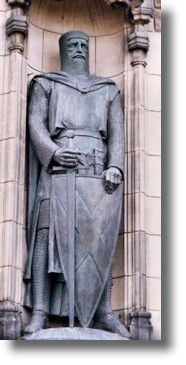
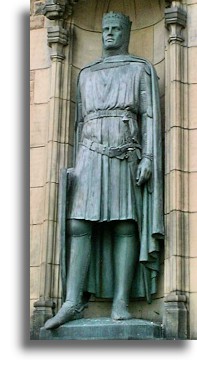
Scots History to 1400
By Michael Lynch
This is a section from the book "Scotland: a New History" by Michael Lynch which covers Scottish history from the earliest times to the present. There is an Index page of all the sections of the book up to the end of the 14th century which have been added to Rampant Scotland. The pages were previously part of the "Scottish Radiance" Web site.
The Evolution of Alba
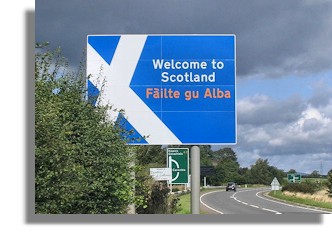 Between 850 and 1050 regnum and gens began to come together, with far-reaching results for the shape of Scottish history. In this period, a federal Pictish kingdom evolved, by accident as much as by design, into Alba, a kingdom expressed in terms of a territory as well as of a group of peoples; kings of Picts became kings of Scots, a new but significant collective name for what was still a collection of separate peoples. The centre of this kingdom still lay in Fortriu, at Scone, but the acquisition of Lothian, south of the 'sea of Scotland', and the loss of the Northern Isles and part of the west to the Norsemen in the ninth century, followed in the tenth by the steady incursion southwards of Norwegian earls of Orkney from their bridgehead in Caithness, provoked a vital shift in its internal balance. For five centuries after this, the kingdom would not begin and end at a natural geographical barrier, from the Pentland Firth to the Forth/Clyde line. It would traverse that 'inland sea' of the Forth and, by 1018, although its frontier line in the north would remain a hazy one, the beginnings of the notion of a southern frontier line at the River Tweed had begun to emerge. This, as much as the better-known twelfth century - which brought the novel force of feudalism to bear on the structure and customs of society - was an age that saw a profound clash between continuity and change. Kings consolidated their power but localities also developed a stronger sense of their own identity; kings of Scots emerged, but so did the mormaers (or 'great stewards') in a number of regions, and especially in Moray. These kings of Scots of the tenth and early eleventh centuries may often have had less power there than kings of Picts in the eighth or early ninth century. A surprising number of kings would meet violent deaths in the north between 900 and 1058.
Between 850 and 1050 regnum and gens began to come together, with far-reaching results for the shape of Scottish history. In this period, a federal Pictish kingdom evolved, by accident as much as by design, into Alba, a kingdom expressed in terms of a territory as well as of a group of peoples; kings of Picts became kings of Scots, a new but significant collective name for what was still a collection of separate peoples. The centre of this kingdom still lay in Fortriu, at Scone, but the acquisition of Lothian, south of the 'sea of Scotland', and the loss of the Northern Isles and part of the west to the Norsemen in the ninth century, followed in the tenth by the steady incursion southwards of Norwegian earls of Orkney from their bridgehead in Caithness, provoked a vital shift in its internal balance. For five centuries after this, the kingdom would not begin and end at a natural geographical barrier, from the Pentland Firth to the Forth/Clyde line. It would traverse that 'inland sea' of the Forth and, by 1018, although its frontier line in the north would remain a hazy one, the beginnings of the notion of a southern frontier line at the River Tweed had begun to emerge. This, as much as the better-known twelfth century - which brought the novel force of feudalism to bear on the structure and customs of society - was an age that saw a profound clash between continuity and change. Kings consolidated their power but localities also developed a stronger sense of their own identity; kings of Scots emerged, but so did the mormaers (or 'great stewards') in a number of regions, and especially in Moray. These kings of Scots of the tenth and early eleventh centuries may often have had less power there than kings of Picts in the eighth or early ninth century. A surprising number of kings would meet violent deaths in the north between 900 and 1058.
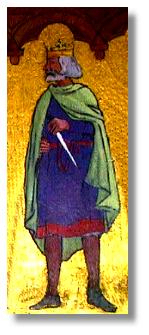
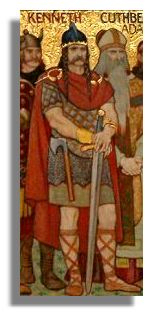
What is often seen as the 'making of the kingdom' of the Scots was a rearrangement of the basic facts of geography as well as of the balance of power between greater and lesser kings. The upshot, at least in terms of geography, was a rather different kingdom, and much of the dual character of Scottish kingship would result: for kings themselves as much as their vital fortress at Stirling, which guarded the first fordable point on the Forth, would be the 'brooch' which held Scotland together. Medieval kings of Scots would lend unity to a people habitually described in royal charters as 'French, English and Scots'; in the case of the charter of King William to Robert de Brus, (granting the huge lands of Annandale in the south-west c.1174, the scribe thought it prudent to add 'and Galwegians'. Yet these vital two centuries form a curiously enigmatic period, which begins and ends with two of the most celebrated but least-known of kings, Kenneth mac Alpin (c.843 -58)(pictured right) and Macbeth (1040 -57)(pictured right).


Between 850 and 1050 regnum and gens began to come together, with far-reaching results for the shape of Scottish history. In this period, a federal Pictish kingdom evolved, by accident as much as by design, into Alba, a kingdom expressed in terms of a territory as well as of a group of peoples; kings of Picts became kings of Scots, a new but significant collective name for what was still a collection of separate peoples. The centre of this kingdom still lay in Fortriu, at Scone, but the acquisition of Lothian, south of the 'sea of Scotland', and the loss of the Northern Isles and part of the west to the Norsemen in the ninth century, followed in the tenth by the steady incursion southwards of Norwegian earls of Orkney from their bridgehead in Caithness, provoked a vital shift in its internal balance. For five centuries after this, the kingdom would not begin and end at a natural geographical barrier, from the Pentland Firth to the Forth/Clyde line. It would traverse that 'inland sea' of the Forth and, by 1018, although its frontier line in the north would remain a hazy one, the beginnings of the notion of a southern frontier line at the River Tweed had begun to emerge. This, as much as the better-known twelfth century - which brought the novel force of feudalism to bear on the structure and customs of society - was an age that saw a profound clash between continuity and change. Kings consolidated their power but localities also developed a stronger sense of their own identity; kings of Scots emerged, but so did the mormaers (or 'great stewards') in a number of regions, and especially in Moray. These kings of Scots of the tenth and early eleventh centuries may often have had less power there than kings of Picts in the eighth or early ninth century. A surprising number of kings would meet violent deaths in the north between 900 and 1058.





